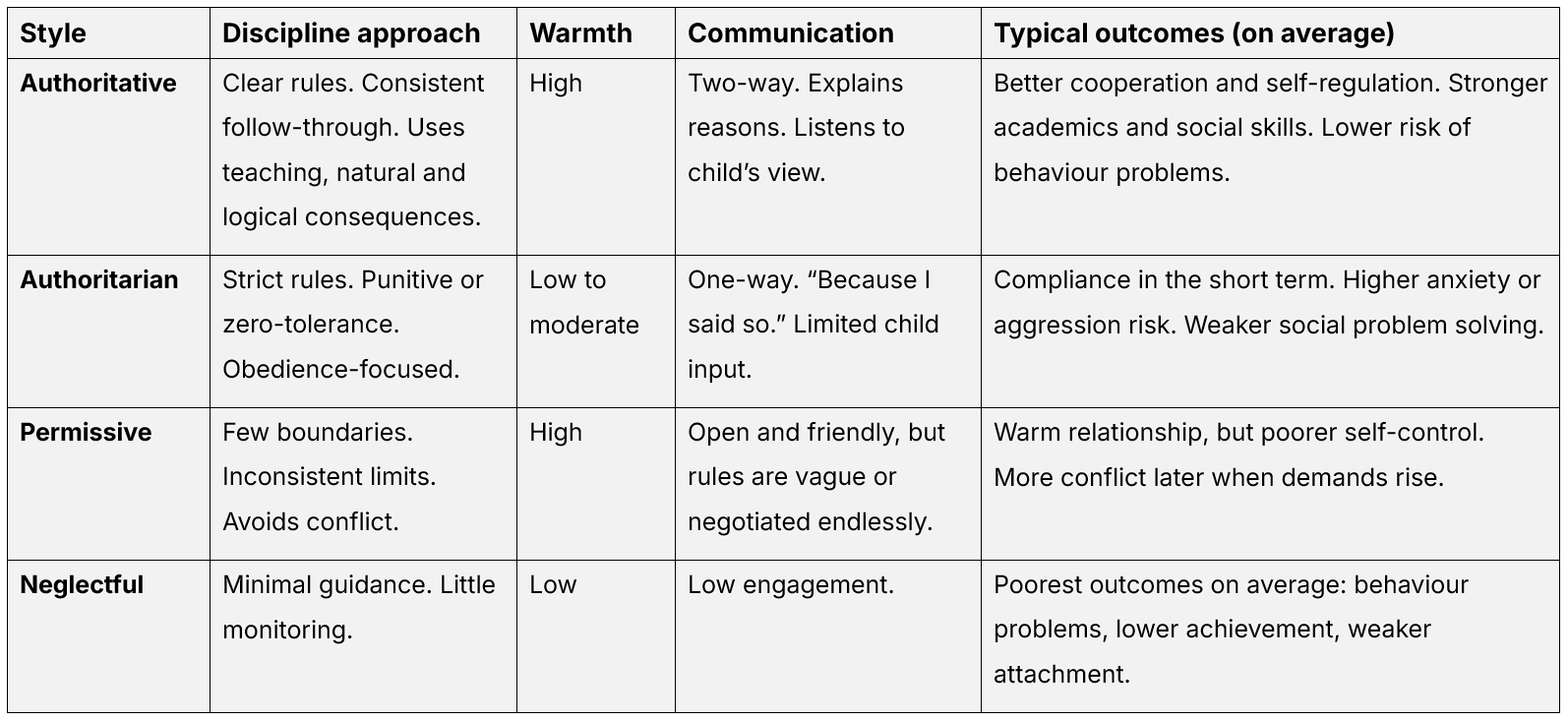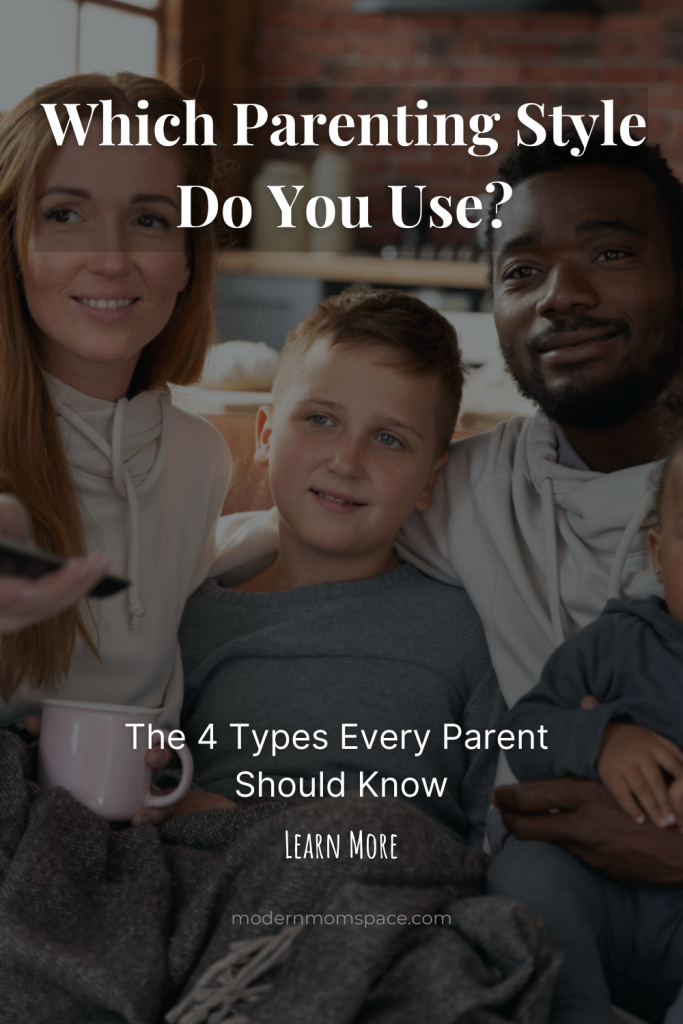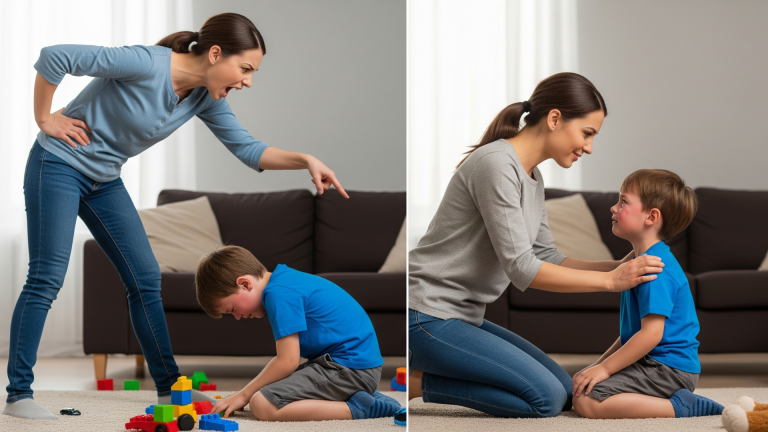The 4 Parenting Styles Explained: Authoritative, Authoritarian, Permissive, and Neglectful
You parent the way you were parented… until your child exposes every weak spot in that plan. That is when “parenting style” stops being an abstract term and starts shaping bedtime, homework, curfew, and who cries in the kitchen at 9:30 p.m.
This is a practical field guide, not a lecture. You will learn what the four styles are, why they matter, and how to spot your default patterns. I will also point you to deeper dives on each style, so you can go from “huh, interesting” to “I can use this on Tuesday.”
Psychologist Diana Baumrind introduced the idea of parenting styles through classic studies in the 1960s and early 1970s. She identified three typical patterns in everyday families: authoritative, authoritarian, and permissive. Later, researchers Eleanor Maccoby and John Martin expanded the model by adding a fourth style: neglectful or uninvolved. Together, these four styles form the most widely used framework for describing the tone and tactics of family life. (iastate.pressbooks.pub)
Goal for this guide: give you a fast, credible overview of all four styles and then send you to our detailed breakdowns if you want more.
What Are Parenting Styles?
Definition. A parenting style is the overall climate of your parenting. It is the mix of warmth, communication, expectations, and follow-through your child experiences most of the time. It is not one decision or one bad day. It is the pattern.
Short history.
You are not locked into one box. Styles describe tendencies. Awareness lets you adjust.
The 4 Parenting Styles at a Glance
Think of the styles like coordinates on two axes: warmth/responsiveness and structure/demandingness. Where you land most days is your dominant style.
Why the tone matters: Style is the context in which specific tactics (bedtime charts, consequences, rewards) either work or backfire. Darling and Steinberg’s influential model puts it plainly: style shapes how open kids are to your guidance, which changes how well any practice lands. (pepparent.org)
Why Parenting Styles Matter
Different styles are associated with different outcomes in kids. Broadly speaking, a large body of research links authoritative parenting with better averages on cooperation, school success, and fewer behavior problems. Authoritarian and permissive patterns are tied to more issues with self-control or aggression, and neglectful patterns correlate with the poorest outcomes. Meta-analyses that pool hundreds of studies show small but consistent advantages for warmth, reasonable control, and autonomy support, and for the authoritative style in particular. Culture and context still matter. Correlation is not destiny. (timothydavidson.com)
You do not need a new personality. You need two adjustments: more warmth where you are cold, and more follow-through where you are loose.
Quick Comparison Table

Note. These are averages across many studies. Individual children, cultures, and stressors vary. The point is not to label yourself forever. The point is to see the pattern and tune it.
Brief Overviews of Each Style
(Click through to the in-depth guides when you are ready to change habits at home.)
Authoritative Parenting: Warm, Firm, and Clear
Snapshot. High warmth and responsiveness with clear boundaries and steady follow-through. Parents explain reasons, invite input, and still make the call. Kids get freedom inside fences.
How it feels at home.
Why it is often the gold standard. Meta-analytic reviews associate authoritative patterns with fewer externalizing problems and better academic or social outcomes, and Darling and Steinberg’s model explains why style boosts the effect of day-to-day practices.
Starter moves.
Authoritarian Parenting: Strict Rules, Low Dialogue
Snapshot. High on control. Lower on warmth and flexibility. Parent leads with rules and expects obedience without much back-and-forth.
How it feels at home.
Why it can backfire. You may get compliance, but kids miss chances to build internal self-control or problem solving. Some studies link authoritarian climates to higher anxiety or aggression, depending on context.
If this is you under stress.
Permissive Parenting: Warmth Without Enough Limits
Snapshot. High warmth and responsiveness. Low structure. Parents avoid conflict, negotiate endlessly, or hope kids mature into responsibility without firm guidance.
How it feels at home.
Why it can backfire. Children need friction against reality to build self-control. Permissive climates often produce kids who are charming but struggle with limits in school or friendships.
If this is you.
Neglectful (Uninvolved) Parenting: Low Warmth, Low Structure
Snapshot. Low responsiveness and low demandingness. Parents are disengaged, overwhelmed, or absent. Kids have too much freedom too soon and not enough coaching.
How it feels at home.
Why it harms. On average, neglectful climates are linked with the poorest outcomes across behavior, achievement, and emotional health. Families in this pattern often face serious stressors and need support to change the climate.
If this is you right now.
Style vs. Practices: The “Why Your Tactics Work” Factor
You can have the cleverest chore chart on the planet. If your style is icy or chaotic, the chart will limp. Darling and Steinberg’s integrative model explains it clearly: style is the context that makes your practices land or bounce. Authoritative climates make kids more open to guidance. Harsh or chaotic climates make them defensive or checked out.
Do not add more hacks. Adjust the climate first: a little more warmth, a little more follow-through.
How to Identify Your Default Style
Use these quick checks. No score, no guilt. Just data.
One-week audit.
Age-by-Age Examples Inside Each Style
These short snapshots show how the tone changes the same situation.
Toddlers, biting at daycare pick-up
School-age, homework stalling
Teens, missed curfew
Takeaway. The words matter less than the pattern. Warmth plus consistent limits teaches best on average.
Moving Toward Authoritative if You Want To
You can shift your climate without doing a personality transplant.
- Connect, then correct. One line to name the feeling. Then the limit.
- Use two good choices. Autonomy inside clear boundaries.
- Keep consequences related and short. Teach the skill. Repair the harm.
- Post the top five rules. Same words. Same follow-through.
- De-brief later. No long lectures in the heat of the moment.
Small challenge. For a week, end each correction with a micro-encouragement: “You reset fast.” “You asked for help.” “You started even when it was boring.” Reinforce what you want more of.
Frequently Asked Questions
Is authoritative always best?
On average across many studies and contexts, authoritative patterns predict better outcomes. That does not mean one size fits all. Culture, stress, and child temperament can change what works. Use the style as a compass, not a cage.
Can I mix styles?
Yes. Most parents do. The goal is to make authoritative your default and keep your stress responses from drifting too far into authoritarian or permissive territory.
What if I was raised authoritarian or permissive?
You are not doomed to repeat it. You can add what was missing in your home growing up. Warmth is a skill. Follow-through is a skill. Practice, review, adjust.
Where do consequences fit?
Consequences should be logical, proportionate, and teaching-focused. Authoritative homes use them, but not as threats. The message is cause and effect, not shame.
Conclusion
You do not need to master every theory to create a home that works. You need a simple map and a few habits you can repeat on your worst day. Parenting styles give you that map. Name your default, tune it toward warmth plus follow-through, and build routines that are boring in the best way.
Next steps.
You are not aiming for perfect. You are aiming for predictable and kind. That is a home kids can grow in.








